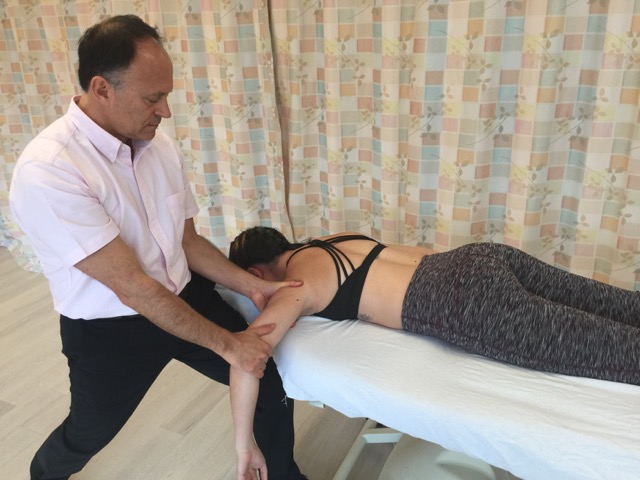Manual therapy treatment:
Manual therapy treatment for a pathologic rotator cuff tendon depends on which tendon is affected, the pathology of the tendon, and what signs and symptoms are accompanying the problem. If the principle pathology of the tendon is a tear, there is nothing that manual therapy can do that directly helps this condition. However, a rotator cuff tear is often accompanied by muscle hypertonicity, and this hypertonicity is usually part of and often the major part of the pain pattern (if the tear is mild to moderate in degree) that the client/patient is experiencing. Therefore, working the muscle tightness and myofascial trigger points might afford the client/patient appreciable relief. Further, decreasing the tone of the rotator cuff musculature can help to decrease the tensile force on the tendons, thereby helping to prevent further tearing. Whenever soft tissue work is done, it is best to begin with light pressure, and then transition toward deeper pressure.
If the principal pathology is tendinitis, manual therapy can be beneficial. Icing and cross fiber soft tissue manipulation (massage) to the affected tendon are indicated. The icing decreases inflammation and the soft tissue manipulation can help to break up adhesions that would otherwise likely form in the area. Of course, if the inflammation is marked in degree, it is important to not work with excessive pressure or the inflammation might be increased. However, if the tendinitis has transitioned into degeneration of the tendon, then deep cross fiber work is indicated, with the intent of creating inflammation to draw in fibroblasts to facilitate the healing process. Sometimes tools (such as gua sha or Graston Technique) are used for this deep cross fiber work.
Digital COMT
Did you know that Digital COMT (Digital Clinical Orthopedic Manual Therapy), Dr. Joe Muscolino’s continuing education video streaming subscription service for massage therapists (and all manual therapists) and movement professionals, has six folders with video lessons on Manual Therapy Treatment, including an entire folder on Stretching, as well as a folder on Pathomechanics, another on Anatomy, and many more? Digital COMT adds seven new video lessons each and every week. And nothing ever goes away! Click here for more information.
Because rotator cuff pathology usually results in decreased use of the shoulder, it is likely that adhesions will form in the capsule of the GH joint. Therefore, mobilization of the GH joint is often beneficial.
Regardless of the type of pathologic condition, the most difficult rotator cuff tendon to treat is the “critical zone” supraspinatus portion because most of it is located deep to the acromion process of the scapula and therefore inaccessible to manual treatment. Passive stretching of the supraspinatus by adducting and extending the arm at the GH joint can help to slightly increase the amount of the supraspinatus tendon that is accessible to manual therapy.
Once direct care to the rotator cuff musculature has been done, it is wise to work the surrounding region from the mid thoracic spine to the elbow joint. Because injury to one side often results in overuse compensation by the other side, it is also beneficial to work the musculature of the opposite side shoulder.
Summary of Manual Treatment Protocol for Rotator Cuff Pathology
| 1. Soft tissue manipulation to the rotator cuff musculature |
| 2. Cross fiber work to the rotator cuff tendons |
| 3. Ice the rotator cuff tendons |
| 4. Mobilization of the GH joint |
| 5. Work the surrounding region |
Precautions/contraindications:
The only precaution when working the rotator musculature, aside from always working within the tolerance and comfort of the client/patient, is to be aware that the radial nerve is superficial between the teres minor and teres major muscles.




